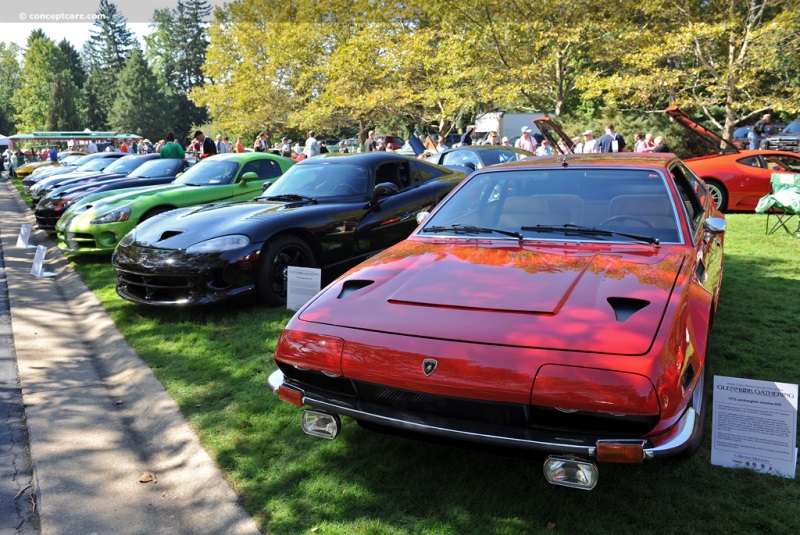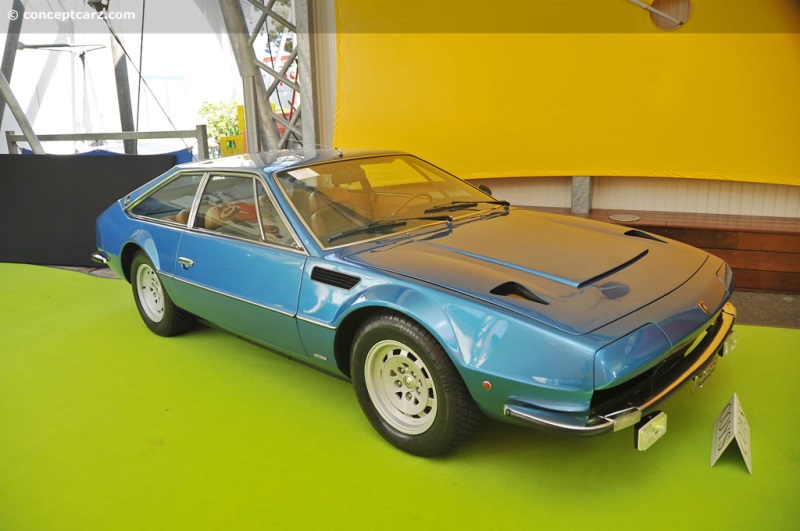History
In the early 1970's, manufacturers that were producing vehicles for the United States had to comply with new government regulations and emission standards that not only made the vehicles safer but more fuel efficient. The Islero was forced to comply in order to continue to be sold in the United States. Marcello Gandini of Bertone was tasked with creating designs that would fit atop of a shortened Espada platform.
In 1970 the Lamborghini Jarama was introduced and stayed in production until 1976. The GT version lasted from 1970 through 1973 while the GTS was produced from 1973 through 1976.
The GT and GTS were very similar in design; most of the changes were to the mechanics. The GT was powered by a V12 engine producing 350 horsepower while the GTS produced 365 horsepower. The GTS was given power assisted steering, an optional Chrysler TorqueFlite automatic transmission, and removable roof panels. The engine had been tuned to produce more horsepower by introducing a new exhaust system, revised heads, carburetion and camshafts. The interior was slightly modified, given new seats that were slimmer, resulting in more rear legroom. Brushed aluminum replaced the wood trim. On the exterior, the GTS had revised taillights, courtesy of the DeTomaso Deauville. Five-bolt wheels replaced the previous wheel rims. Air intake could now be found on the hood and behind each front wheel were air-extraction openings.
During the entire production run for the Jarama, 327 examples were produced. 177 examples were of the GT version. 10 examples were produced with the optional automatic transmission on the GTS. On display in the Official Lamborghini museum is Ferruccio Lamborghini's own personal Jarama GTS, chassis number 10418.
By Daniel Vaughan | Mar 2006
In 1970 the Lamborghini Jarama was introduced and stayed in production until 1976. The GT version lasted from 1970 through 1973 while the GTS was produced from 1973 through 1976.
The GT and GTS were very similar in design; most of the changes were to the mechanics. The GT was powered by a V12 engine producing 350 horsepower while the GTS produced 365 horsepower. The GTS was given power assisted steering, an optional Chrysler TorqueFlite automatic transmission, and removable roof panels. The engine had been tuned to produce more horsepower by introducing a new exhaust system, revised heads, carburetion and camshafts. The interior was slightly modified, given new seats that were slimmer, resulting in more rear legroom. Brushed aluminum replaced the wood trim. On the exterior, the GTS had revised taillights, courtesy of the DeTomaso Deauville. Five-bolt wheels replaced the previous wheel rims. Air intake could now be found on the hood and behind each front wheel were air-extraction openings.
During the entire production run for the Jarama, 327 examples were produced. 177 examples were of the GT version. 10 examples were produced with the optional automatic transmission on the GTS. On display in the Official Lamborghini museum is Ferruccio Lamborghini's own personal Jarama GTS, chassis number 10418.
By Daniel Vaughan | Mar 2006
With subdued looks that belied its V12 power, the Lamborghini Jarama was among the very last of Lamborghini's grand touring cars before the Italian carmaker decided to pursue fulltime the production of two-seat supercars. The Jarama was built in the same spirit as the very first Lamborghinis. It was comfortable and capable, with no more flash than necessary.
Created to replace the Lamborghini Islero, the Jarama was first produced for 1970. It was based on a modified Espada platform and, though the Jarama was far from being a featherweight sports car, it was a potent yet understated grand touring car.
The Espada platform was shortened by 10.6 inches when used for the Jarama, but it was otherwise altered very little. This gave the Jarama odd proportions, making it appear particularly wide. Marcello Gandini, working for the Bertone design house, was tasked with creating the Jarama's shape. His efforts were admirable given the awkward platform with which he was working, but the Jarama nevertheless had an unconventional style that made it stick out against its finely sculpted competitors.
The Jarama may have inherited its strange proportions from the Espada, but it also took from that car a wonderful engine. Displacing 3,929cc, the quad-cam V12 in the Jarama produced 350bhp at 7,500rpm from the outset of production. A 26-gallon fuel tank ensured that, despite the Jarama's prodigious weight and thirst, its six Webers would remain well-fed for many miles at a time.
Final assembly of the Jarama was conducted by Marazzi, and two versions were built. The first was the Jarama 400GT. This model had the cleaner styling of the two variants, and was equipped with the Miura's center-lock wheels. Between 1970 and 1973, 177 examples of the 400GT were made before the updated Jarama GTS was introduced. The GTS model could be visually distinguished by its five-bolt wheels, as well as by vents in the front fenders and an additional air scoop that was mounted between NACA ducts on either side of the hood. Beneath the revised exterior, the GTS featured an even more powerful engine that, with 365bhp, produced 15bhp more than the GT. This, combined with lower weight, enabled the Jarama 400GTS to reach 161mph, a top speed 9mph greater than the first Jarama. There were 150 examples of the Jarama 400GTS built from 1973 to 1976.
Power from the Jarama's V12 was typically sent through a 5-speed manual gearbox, but Lamborghini made a Chrysler TorqueFlite automatic transmission optional on the 400GTS. About 10 examples were produced with the TorqueFlite transmission, making it a very rare option.
The Jarama, with its odd styling and low sales volume, has failed to reach the status of Lamborghini's most famous models. It has been overshadowed by Lamborghini's racier offerings, as well as by the company's earlier and prettier and GT cars. The Jarama is a capable grand touring machine, though, and its low production numbers and strange styling only serve to make it an undeniably unique Lamborghini.
Sources:
'Classic Line up at Lamborghini Cars.' Lamborghini Cars: The Enthusiast Site n. pag. Web. 3 Jun 2010. http://www.lambocars.com/cla/index.php.
'Lamborghini Jarama.' International Lamborghini Registry n. pag. Web. 3 Jun 2010. http://www.lamborghiniregistry.com/Forums/Jaramas.php.By Evan Acuña
Created to replace the Lamborghini Islero, the Jarama was first produced for 1970. It was based on a modified Espada platform and, though the Jarama was far from being a featherweight sports car, it was a potent yet understated grand touring car.
The Espada platform was shortened by 10.6 inches when used for the Jarama, but it was otherwise altered very little. This gave the Jarama odd proportions, making it appear particularly wide. Marcello Gandini, working for the Bertone design house, was tasked with creating the Jarama's shape. His efforts were admirable given the awkward platform with which he was working, but the Jarama nevertheless had an unconventional style that made it stick out against its finely sculpted competitors.
The Jarama may have inherited its strange proportions from the Espada, but it also took from that car a wonderful engine. Displacing 3,929cc, the quad-cam V12 in the Jarama produced 350bhp at 7,500rpm from the outset of production. A 26-gallon fuel tank ensured that, despite the Jarama's prodigious weight and thirst, its six Webers would remain well-fed for many miles at a time.
Final assembly of the Jarama was conducted by Marazzi, and two versions were built. The first was the Jarama 400GT. This model had the cleaner styling of the two variants, and was equipped with the Miura's center-lock wheels. Between 1970 and 1973, 177 examples of the 400GT were made before the updated Jarama GTS was introduced. The GTS model could be visually distinguished by its five-bolt wheels, as well as by vents in the front fenders and an additional air scoop that was mounted between NACA ducts on either side of the hood. Beneath the revised exterior, the GTS featured an even more powerful engine that, with 365bhp, produced 15bhp more than the GT. This, combined with lower weight, enabled the Jarama 400GTS to reach 161mph, a top speed 9mph greater than the first Jarama. There were 150 examples of the Jarama 400GTS built from 1973 to 1976.
Power from the Jarama's V12 was typically sent through a 5-speed manual gearbox, but Lamborghini made a Chrysler TorqueFlite automatic transmission optional on the 400GTS. About 10 examples were produced with the TorqueFlite transmission, making it a very rare option.
The Jarama, with its odd styling and low sales volume, has failed to reach the status of Lamborghini's most famous models. It has been overshadowed by Lamborghini's racier offerings, as well as by the company's earlier and prettier and GT cars. The Jarama is a capable grand touring machine, though, and its low production numbers and strange styling only serve to make it an undeniably unique Lamborghini.
Sources:
'Classic Line up at Lamborghini Cars.' Lamborghini Cars: The Enthusiast Site n. pag. Web. 3 Jun 2010. http://www.lambocars.com/cla/index.php.
'Lamborghini Jarama.' International Lamborghini Registry n. pag. Web. 3 Jun 2010. http://www.lamborghiniregistry.com/Forums/Jaramas.php.By Evan Acuña
Similar Automakers
Similarly Sized Vehicles
from 1973
1973 Lamborghini Jarama Vehicle Profiles
Recent Vehicle Additions
Performance and Specification Comparison
Jarama GTS Specification Comparison by Year
Year
Production
Wheelbase
Engine
Prices
Related Automotive News

Automobili Lamborghini's history on the ice in St. Moritz
Lamborghini Polo Storico stars at The I.C.E. Concours dÉlégance, featuring the Jarama GTS and 400 GT 22 from the Lamborghini Museum in SantAgata Bolognese
Automobili Lamborghini participated in The I.C.E. (International...

The Best Of Lamborghini At London Concours 2020
The London Concours has announced its Great Marques Lamborghini display, celebrating the very best from SantAgata
Line-up includes icons early pioneers like the 400GT and iconic Miura, through to the Diablo SV, Murcielago and Aventador SVJ
Les...

Alpine Passion Through The Years At Retromobile
Retromobile set to play host to six classic Alpine models
The Alpine Vision show car will also be on display as a symbolic bridge between the brands past and future
Groupe Renault is pleased to confirm Alpines participation in the 42nd Retromobi...

IT'S SHOWTIME SATURDAY AT THE STUNNING SILVERSTONE CLASSIC
Huge crowds wowed by 11 rousing retro showdowns
Wins for Williams, Aston Martin, Matra and Ferrari
Porsche Club GB takes Scarf and Goggles Award
Spotlight now switches to Tin Top Sunday
Even by its own record-breaking standards, Saturday (30...

A NEW SPRING TRADITION: AUCTIONS AMERICA POSTS $7.2 MILLION, WELCOMES STRONG NEW INTEREST AT AUBURN SPRING
Auctions America realizes total sales of %247.2 million at its annual Auburn Spring event, an increase of 40 percent over 2015
Top sales led by a 1968 Ferrari 365 GT 22, a 1970 Ford Mustang Boss 429, and a 1968 Shelby GT 500 Fastback
Host of add...

Fiat Chrysler Automobiles key player in the Classic Days in Germany
Concours delegance, parades and special races on roads closed to traffic this is the packed programme reserved for the historic cars arriving at the medieval Dyck castle
Alfa Romeo takes part with four precious models the prototype 750 Competizi...


















